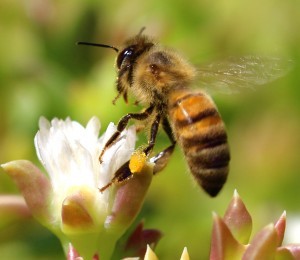23
Mar
Vermont House Votes to Authorize State Regulation of “Treated Articles,” such as Neonic-Coated Seeds
(Beyond Pesticides March 23, 2016) Last week, the Vermont House of Representatives passed a bill that authorizes state regulation of pesticide-treated products, including telephone poles and coated seeds, that are exempt from federal pesticide regulations. H.861 is the latest in a string of laws introduced this legislative session in Vermont to address the impact of harmful neonicotinoid insecticides on Vermont’s ecology and agriculture, and symbolizes a concentrated effort by the legislature to reverse pollinator declines within the state. If passed by the Senate and signed by the governor, the bill will allow the Secretary of Agriculture to regulate above and beyond current federal laws, which exempt treated articles from regulation completely, and write appropriate rules in response to recommendations from a state Pollinator Protection Committee.
 The bill, which passed with wide support in the House, gives the Vermont Agency of Agriculture, Food and Markets the authority to regulate “treated articles,” a term coined by the Environmental Protection Agency (EPA) to denote products treated with pesticides, such as utility poles, commercial crop seeds, and lumber. Traditionally, EPA gives rulemaking authority over pesticides to states, but that authority does not extend to products pre-treated with pesticides, which, until this point, has posed a problem for states like Vermont that wish to adapt to growing concerns over the prevalent use of neonicotinoid-coated seeds and their impact on pollinator species.
The bill, which passed with wide support in the House, gives the Vermont Agency of Agriculture, Food and Markets the authority to regulate “treated articles,” a term coined by the Environmental Protection Agency (EPA) to denote products treated with pesticides, such as utility poles, commercial crop seeds, and lumber. Traditionally, EPA gives rulemaking authority over pesticides to states, but that authority does not extend to products pre-treated with pesticides, which, until this point, has posed a problem for states like Vermont that wish to adapt to growing concerns over the prevalent use of neonicotinoid-coated seeds and their impact on pollinator species.
“Not regulating toxic substances that may pose a threat to humans or the environment would be reckless and irresponsible,” said Rep. Teo Zagar, D-Barnard, a member of the House Committee on Agriculture and Forest Products where the bill originated.” We’ve learned too many things the hard way.”
Neonicotinoid seed treatments have become increasingly common and are linked to the explosion of genetically engineered (GE) crops. At least 94% of the nation’s 92 million acres of corn —greater than the total size of the state of Minnesota, Nebraska, or both Dakotas— will be treated with one of two neonicotinoids, both manufactured by Bayer CropScience. Currently, when farmers plant pesticide-treated, or coated, seeds using a mechanical seeder, lubricants used to keep the seeds from sticking to the planter mechanism become contaminated are and expelled from the equipment as fugitive dust. The dust contaminates nearby plants . A 2012 study found that high amounts of neonicotinoids are present in the exhaust of corn seed planters and that bees are exposed to these potentially lethal concentrations of the chemical simply by flying through the area during planting.
In June 2014, in a letter to EPA and the U.S. Department of Agriculture, the Center for Food Safety (CFS) challenged EPA’s position that seeds coated with pesticides, commonly neonicotinoid pesticides, are exempt from regulation under the Federal Insecticide Fungicide and Rodenticide Act (FIFRA). EPA argued that pesticide-coated seeds are treated articles, exempting them from being regulated as a pesticide and should be regulated by USDA under the Federal Seed Act. CFS responded in early 2016 by filing a lawsuit in federal court charging the EPA with failing to adequately regulate neonicotinoid insecticide seed coatings used on dozens of crops throughout the U.S. The suit alleges that EPA has illegally allowed millions of pounds of coated seeds to be planted annually on more than 150 million acres nationwide, constituting a direct violation of the registration requirements established by the Federal Insecticide, Fungicide and Rodenticide Act (FIFRA). Vermont is the first state to take action to address the regulatory problems created by the treated article exemption.
As mentioned above, H. 861 is designed to give the Secretary of Agriculture the ability to regulate neonicotinoid coated seeds based on the recommendations of a state Pollinator Protection Committee. The creation of this committee is dependent on the passage of another legislative measure, H.539, which would establish the Committee to “evaluate the causes of reduced pollinator populations in the State” and “recommend measures the State can adopt to conserve and protect pollinator populations.” While the creation of a Pollinator Protection Committee would be a positive undertaking by the state of Vermont, another piece of legislation currently being considered by the Senate would have a more immediate and long-lasting effect on pollinator populations within the state. S.200 will ban the use, sale, or application of neonicotinoid pesticides in Vermont outright without waiting for a committee to confirm the well-documented scientific link between use of neonicotinoid pesticides and pollinator declines. S.200 currently awaits review by the Senate Agriculture Committee.
Regardless of whether Vermont decides to ban neonicotinoids or to establish a committee to explore the topic further, proactive State steps to address the issue of pollinator decline is critical in the absence of federal action. Beyond Pesticides has long advocated a regulatory approach that prohibits high hazard chemical use and requires alternative assessments. Farm, beekeeper, and environmental groups, including Beyond Pesticides, have urged EPA to follow in the European Union’s footsteps and suspend the huge numbers of other bee-harming pesticides already on the market. We suggest an approach that rejects uses and exposures deemed acceptable under risk assessment calculations, and instead focuses on safer alternatives that are proven effective, such as organic agriculture, which prohibits the use of neonicotinoids. See how you can help through Bee Protective.
Source: VTDigger
All unattributed positions and opinions in this piece are those of Beyond Pesticides.










